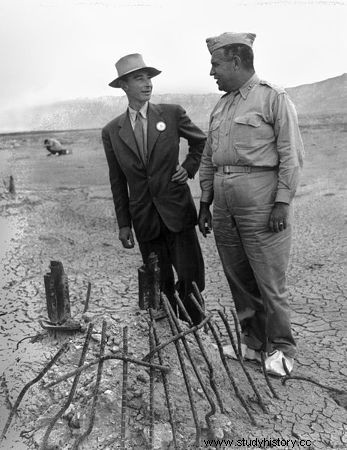
What was the Manhattan Project?
Manhattan Project was the name given to the great mobilization of military and scientific efforts with a view to the construction of the first atomic bombs of the story. The project was an initiative of the United States of America and lasted from August 13, 1942 until August 15, 1947. The first explosion test of an atomic bomb was carried out at the secret base of the Manhattan Project, located in the Los Alamos Desert, New Mexico, July 16, 1945. On the 6th and 9th of the following month, two more project-built bombs were dropped on the Japanese cities of Hiroshima and Nagasaki , causing the death of more than 240 thousand people.
Project creation context
In August 1939, a month before the start of World War II , US President Franklin D. Roosevelt , received a letter signed by physicists Albert Einstein and Leo Szilard , but written almost entirely by the latter in line with the ideas of two other physicists, Edward Teller and Eugene Paul Wigner . The letter brought the president a warning message about the possibility of the Nazi regime building an atomic bomb. This warning was based on the advanced knowledge that German physicists under Nazi control, such as Werner Heisenberg , had about atomic energy.
With the outbreak of war in September, the warning of the aforementioned scientists set off a secret race for the US to get ahead of the possible German atomic project. This ended up in mobilizing resources for the construction of the world's firstnuclear reactor o, which was completed in Chicago in 1942.
The fact is that Hitler , according to historians such as P. D. Smith, was skeptical of the use of atomic energy as a weapon of war and focused his attention more on the first ballistic missiles conventional explosive (V-1 and V-2 ), built by their engineers, than any other weapon.
However, the atmosphere of extreme tension caused by the war accelerated the process of building the first nuclear weapons. In the year that the first atomic reactor began operating in Chicago, in 1942, the Manhattan Project began, which was headed by General Leslie Groves and the physicist Robert Oppenheimer , the latter being the general director of the project.
Trinity :the first atomic bomb
The production of the first atomic bombs mobilized thousands of people – almost 200,000 in the first year alone –, from scientists and engineers, who enriched uranium, to soldiers, firefighters, janitors, technicians, etc. . According to historian P. D. Smith, there were four main headquarters for the Manhattan Project:
[…] In addition to the Met Lab in Chicago, there was Oak Ridge, near Clinton, Tennessee, where uranium-235 was separated from uranium-238 ,; and Hanford, near the city of Richland, Washington, where the reactors that produced plutonium and the facilities that separated it from uranium fuel were located. The fourth location in the top-secret superweapon project was Los Alamos, the laboratory where the bombs were designed and manufactured. [1] P. 333.
The result of all this mobilization was the test with the first of the bombs, named Trinity . The test was carried out at Los Alamos, New Mexico, on July 16, 1945. The explosion had the force of 20 kilotons, that is, 20 kilotons of TNT, conventional dynamite.
The “success” of Trinity negatively and positively impressed those involved in the project. Many scientists, including Einstein and Szilard, were appalled by the outcome and repudiated the final decision by the US military command to drop two more project bombs on Hiroshima and Nagasaki. These bombs were nicknamed, respectively, Little Boy and Fat Man and were dropped by the B-29 bomber plane, Enola Gay .
Comparison to a volcano explosion
Historian P. D. Smith, commenting on the impressions of journalist William L. Laurence , which was present in the test with Trinity, points out that the immediate comparison of the experience was with the explosion of a volcano, but on a much more terrifying scale. Says Smith, quoting Laurence:
For “a very short time, but an extremely long time”, the landscape around him and everyone on the hill remained in absolute and ghastly silence. as they stared in amazement at the expanding fireball. It was like “a vibrant volcano that shot fire to the sky”. Thirty years earlier, Wells, too, had imagined an atomic explosion by comparing it to a volcano. Then, about a hundred seconds after the flash, came "the first wail of the newborn world." “Thunder rumbled across the desert and reverberated from the Sierra Oscura, echo upon echo. The ground shook like an earthquake.” He promised, as Laurence said, "to break the shackles and bring to the earth a new fire." [2]
To get a better idea of what this experience was like and Laurence's comparison, here's a video of the Trinity explosion , engraved from inside the protective enclosure built in Los Alamos:
The association between the explosion of the atomic bomb and the explosion of a volcano becomes clearer when you realize the shock wave that both cause. Let's see below how the shock wave propagates after the explosion of a volcano:
Of course, the intensity of a volcano explosion is substantially less than that of an atomic bomb. However, the above comparison gives us an idea of the impact that something invented by man has on the forces of nature.
NOTES
[1] SMITH, P.D. The End of the World Men:The Real Dr. Fantastic and the dream of the total weapon. (transl. José Viegas Filho). São Paulo:Companhia das Letras, 2008. p. 333.
[2] Ibid. P. 341.
By me. Claudio Fernandes
